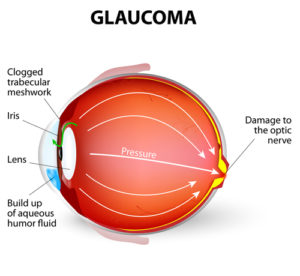
Have you or someone you love recently received a glaucoma diagnosis? You may have questions about what to expect or what to know about the eye condition.
Glaucoma is one of the leading causes of blindness in adults over 60. While quite common, many people who develop glaucoma aren’t aware they have it until it’s too late.
Glaucoma is an irreversible vision condition, meaning once vision loss occurs, it’s permanent. Glaucoma doesn’t present any symptoms in the early stages.
Symptoms of glaucoma only become noticeable when it’s begun to cause visual issues. Once glaucoma is developed enough that it causes vision loss, that vision is gone.
For this reason, glaucoma is often called the Silent Thief of Sight. But you don’t have to live in fear of glaucoma.
Although there’s no cure for glaucoma, it is treatable. Treatment is most effective in its early stages.
Early diagnosis in the early stages of glaucoma is only possible by receiving regular eye exams. Keep reading to learn more about what glaucoma is, what causes it, how it affects your vision, and how you can prevent permanent vision loss.
What is Glaucoma?

Glaucoma is a collection of eye diseases that all have one thing in common: they cause damage to the optic nerve. The optic nerve is what connects your eye to your brain.
When the optic nerve suffers damage, your eye can’t send a complete picture of what you’re seeing. Patients with glaucoma lose their peripheral vision first.
As the eye condition causes more damage to the optic nerve, the vision begins to tunnel, resulting in the field of vision becoming smaller and smaller. A buildup of pressure in the eye causes almost all forms of glaucoma.
Your eyes are filled with a fluid called aqueous—the aqueous flows in and out of various chambers in the eye to keep them healthy.
But when the channels that aqueous flows through become blocked off, your intraocular pressure, or IOP, rises. The pressure eventually puts a strain on the optic nerve, damaging it.
Luckily, you may have high intraocular pressure and not have any significant optic nerve damage. But elevated IOP is the first warning sign of glaucoma. To prevent further damage to the optic nerve, it’s necessary to treat increased intraocular pressure levels.
Common Types of Glaucoma
There are many types of glaucoma, but two forms are far more common than the rest. Open-angle glaucoma is by far the most common form of glaucoma.
Angle-closure glaucoma is far less common, although it’s more common than rarer forms like congenital glaucoma and normal tension glaucoma.
Open-Angle Glaucoma
Open-angle glaucoma occurs when the primary drainage channel, or angle, that exists between the cornea and iris is open. But the many smaller channels around the eye, called the trabecular meshwork, are blocked off somehow.
When the trabecular meshwork becomes blocked, it causes a gradual pressure buildup and doesn’t show symptoms until it is high enough to damage the optic nerve.
Angle-Closure Glaucoma
Angle-closure glaucoma occurs when the primary drainage angle closes. The primary drainage angle closes when the iris bulges.

It can happen extremely quickly if it’s acute, causing a fast buildup of pressure. Unlike other forms of glaucoma, acute angle-closure glaucoma causes apparent symptoms.
These include blurry vision, severe eye pain, headache, nausea, and vomiting. If you experience these symptoms, seek emergency medical attention, as this pressure must be relieved quickly through surgery to prevent optic nerve damage. When angle-closure glaucoma is not treated, it can result in permanent vision loss.
Prevention
You can’t prevent glaucoma. But you can prevent vision loss from glaucoma by being aware of the condition and your risk for it and having regular eye exams accordingly.

Your eye doctor can help you determine your risk for glaucoma, but you should know the primary risk factors include:
- Being over 55
- Having high blood pressure
- Diabetes
- Being of African or Hispanic descent
- Thin corneas
- Extended use of corticosteroids
- Severe nearsightedness or farsightedness
- Having a known family history of glaucoma
While you can’t prevent glaucoma, you can lower your risk of developing the vision-stealing condition by leading a healthy lifestyle. Diabetes and high blood pressure are significant risk factors and can often be prevented with proper diet and exercise.
However, you have no control over many risk factors, so you must see your eye doctor regularly, no matter how high your risk is. If you have glaucoma, receiving an early diagnosis is the best-case scenario.
With early diagnosis, you can seek early treatment before any permanent vision loss occurs or preserve your remaining vision.
Treating Glaucoma
There are a variety of treatments for glaucoma and open-angle glaucoma in particular. What treatment your eye doctor will recommend depends on how severe your particular case of glaucoma is.
Multiple treatment types are often necessary to prevent or slow vision loss.
Medication

Medication in the form of eye drops is usually the first line of defense against vision loss. Prescription eye drops can be prescribed that lower your intraocular pressure.
You can use these eye drops even if you have high intraocular pressure without glaucoma. Your eye doctor may also prescribe oral medications to help lower your IOP.
Surgical Procedures
Surgery is often used when medication alone isn’t enough to lower your intraocular pressure levels. There are a variety of glaucoma procedures.
Most are designed to lower IOP by creating new drainage channels in the eye. Sometimes a surgeon can implant a tiny drainage device in the eye to help lower intraocular pressure.

There are also laser treatments that help open up the trabecular meshwork. Which procedure your eye doctor recommends will depend on your symptoms and if your intraocular pressure hasn’t responded to other methods or medications.
Learn more about glaucoma and potential treatment options by requesting an appointment at St. Luke’s Eye at The Villages today!









